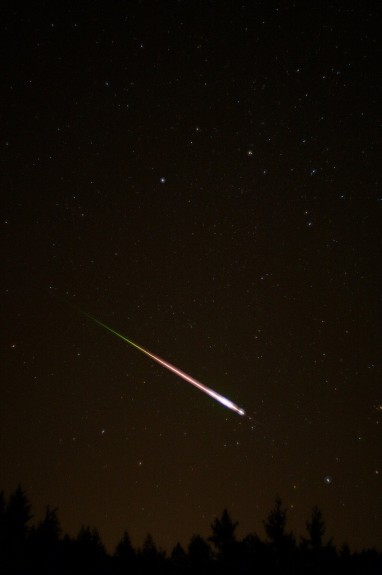This Tuesday Morning, Debris of a Dying Comet Should Produce Extremely Bright Meteors
The annual Leonid meteor shower peaks this weekend

A meteor burns up in Earth’s atmosphere during the 2009 Leonid meteor shower. Photo: Ed Sweeney
The comet Temple-Tuttle was first identified in 1699 by Gottfried Kirch, a German shoemaker-turned astronomer working in Leipzig. It took on its name more than a hundred years later, when it was independently re-discovered by Ernst Tempel and Horace Tuttle in the 1860s. Every 33 years, the comet blows past the Earth as it swings around the Sun, leaving in its wake—and in Earth’s path—a field of debris, shed from the slowly-decaying comet.
This field of debris, in turn, gives rise to the annual astronomical event known as the Leonid meteor shower. Every November, arcing in from the east out of the constellation Leo, some of the Tempel-Tuttle debris slams into Earth’s atmosphere, burning up in a brilliant display. Space.com:
While the Leonid meteor shower has a history of putting on stupendous displays, this year will not be one of them; at best 10 to 15 meteors per hour may be seen. This year is a bit unusual in that the Leonids are expected to show two peaks of activity, one on Saturday morning (Nov. 17) and another on Tuesday morning (Nov. 20).
But don’t let the low meteor count get you down, says The Guardian.
In terms of numbers, the Leonids do not compare to the Perseids, which reach 100 meteors an hour, but it’s quality not quantity that counts here. Whereas the Perseids can often be faint, the Leonids have a reputation for brightness.
Extremely bright meteors, known as fireballs, are often associated with this shower. These are produced by dust grains about 10 millimetres across burning up in our atmosphere.
To find the best views for the Leonid shower, says Universe Today, you’ll want to wait until the wee hours of the morning.
If you wait until the hours before dawn this weekend, the Moon will be below the horizon, so its light will not interfere with seeing meteors. Astronomers says that with clear skies, viewers can expect to see about 15 to 20 meteors per hour, though the shower has proved highly variable in recent years.
Though the meteors will appear to originate from the constellation Leo, which will be in the eastern sky in the early morning hours, the meteors can be seen in all parts of the sky.
More from Smithsonian.com:
A Comet’s Death Caught on Camera
A Newly Discovered Comet Is Headed Our Way
A Comet’s Close Call
/https://tf-cmsv2-smithsonianmag-media.s3.amazonaws.com/accounts/headshot/smartnews-colin-schultz-240.jpg)
/https://tf-cmsv2-smithsonianmag-media.s3.amazonaws.com/accounts/headshot/smartnews-colin-schultz-240.jpg)